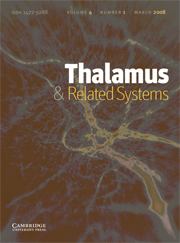Article contents
Interactions of synaptic and intrinsic electroresponsiveness determine corticothalamic activation dynamics
Published online by Cambridge University Press: 12 April 2006
Abstract
The interaction between cortical input frequency and intrinsic thalamic neuron (TN) properties were investigated using intracellular recordings from mice TNs in thalamocortical (TC) slices. Excitatory postsynaptic potentials (EPSPs) of corticothalamic (CT) origin were recorded at TN membrane potentials (Vm) held, by current clamp means, between −59 and −55 mV to avoid low-threshold calcium currents (IT) activation. EPSPs elicited in ventrobasal neurons (n = 25) by stimulation in the internal capsule showed constant latency, relatively fast rise time (2.9 ± 0.56 ms) and short duration (26.6 ± 9.11 ms). EPSPs evoked by threshold stimulation (n = 10) showed similar characteristics (mean rise time, 2.74 ± 0.42 ms; mean duration, 30 ± 8.00 ms). The time course of CT synaptic facilitation was determined using pairs of stimuli. Paired-pulse facilitation (PPF) of CT EPSPs peaked at 25–30 ms stimulus intervals and decayed exponentially with an average time constant of 130 ms (n = 50). Application of the NMDA receptor blocker APV (25 μM, n = 4) did not modify PPF for any interstimulus interval studied but suppressed frequency facilitation evoked by trains of CT stimuli. We compared the number of spikes per stimulus (Fs) evoked in TNs by repetitive CT stimulation over a range of frequencies at different Vm. At hyperpolarized Vm (below −65 mV) and frequencies of stimulation ≥ 10 Hz, Fs decreased along the train while at depolarized Vm (above −59 mV) Fs increased along the train. Decremental patterns resulted from the activation of IT while facilitatory patterns emerged from superposition of synaptic and intrinsic mechanisms. At hyperpolarized Vm, steady-state Fs was maximal for frequencies ≤ 2 Hz, intermediate for frequencies between 2 and 10 Hz and zero at ≥ 10 Hz. At depolarized Vm, steady-state Fs increased with increasing frequencies (from 1 to 40 Hz).
We conclude that the CT–TN junctions are tuned to establish stable thalamocortical resonant dynamics.
Information
- Type
- Research Article
- Information
- Copyright
- 2001 Elsevier Science Ltd
- 8
- Cited by

